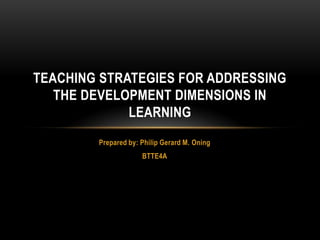
Teaching Strategies for Accessing the Development Dimensions in Learning
- 1. TEACHING STRATEGIES FOR ADDRESSING THE DEVELOPMENT DIMENSIONS IN LEARNING Prepared by: Philip Gerard M. Oning BTTE4A
- 2. THE DIMENSIONS OF LEARNING Dimensions of Learning is a comprehensive framework or model to help educators plan learning experiences for their students. It is based on extensive research about learning and how the mind works. It has been designed to help educators improve students' learning through planning curriculum, instruction and assessment using five critical aspects of the learning process, or dimensions of learning. • Dimension 1: Attitudes and Perceptions • Dimension 2: Acquire and Integrate New Knowledge • Dimension 3: Extend and Refine Knowledge • Dimension 4: Using Knowledge Meaningfully • Dimension 5: Habits of Mind
- 4. ATTITUDES AND PERCEPTION • Attitude is a settled way of thinking or feeling, typically reflected in a person's behavior. • Perception refers to the ability to see, hear, or become aware of something through the senses. • The attitudes of learners, their peers and teachers influence learning. Classroom Climate • Feel accepted by teachers and peers • Experience a sense of comfort and order Classroom Tasks • Perceive tasks as valuable and interesting • Believe they have the ability and resources to complete tasks • Understand and be clear about tasks
- 5. ACQUIRE AND INTEGRATE NEW KNOWLEDGE • Acquire means to learn or develop (a skill, habit, or quality). • Integrate means to bring into equal participation in, relate, or connect. • Learning requires both the acquisition of information and the ability to retrieve and reconstruct that information whenever necessary. Two different kinds of knowledge: • Declarative Knowledge which includes facts, concepts and generalizations. • Procedural Knowledge which includes skills and processes.
- 6. DECLARATIVE KNOWLEDGE • Construct Meaning - Link new information to prior knowledge: Descriptions, time sequences, cause effect, episodes, generalizations, concepts, similarities/differences, 3 minute pause • Acquire and Integrate Knowledge - Identify patterns in information: Graphic organizers, advance organizers, note taking strategies, graphs and charts • Internalize/Store Knowledge - Consciously store information in memory: Symbols, substitutes, links, structured systems, and mnemonics.
- 7. PROCEDURAL KNOWLEDGE • Construct Model - Demonstrations and modeling: Construct steps, think aloud, graphic representation, similarities and differences, mentally rehearse • Shape - Provide feedback and refine process: Narrative, practice variations, identify common errors, integrate knowledge & skill • Internalize - Practice and use: Practice schedule, chart & report, establish connectedness & relevance.
- 9. EXTEND AND REFINE KNOWLEDGE • Extend is to expand in scope, effect, or meaning. • Refine means to improve (something) by making small changes, in particular make (an idea, theory, or method) more subtle and accurate. • Analyzing knowledge in ways that involve the application of more complex reasoning processes (higher order thinking). • Transforming the knowledge into another form, for example metaphoric expression through visual arts, theatre/drama or poetry. Eight Complex Reasoning Processes: Comparing Classifying Abstracting Constructing Support Analyzing Errors Analyzing Perspectives Deductive Reasoning Inductive Reasoning
- 10. USE KNOWLEDGE MEANINGFULLY • Learners will internalize knowledge more effectively when they are able to use it to perform a meaningful task; this is particularly pertinent for assessment. • Meaningful (or authentic) tasks are those that use real life or life-like contexts for students to demonstrate their knowledge and skills within. Six Reasoning Processes: Decision Making Problem Solving Invention Investigation Experimental Inquiry Systems Analysis
- 11. HABITS OF MIND • Habits of Mind are the kinds of productive mental habits that successful learners utilize . • It means having a disposition toward behaving intelligently when confronted with problems, the answers to which are not immediately known. Three Major Organizers for Habits of Mind: • Critical thinking • Creative thinking and • Self-regulated thinking
- 12. HABITS OF MIND Art Costa has expanded on the Habits of Mind and he identifies sixteen. These are: • Persisting • Gathering data through all senses • Managing Impulsivity • Creating, imagining, innovating • Listening with understanding & empathy • Responding with wonderment & awe • Thinking flexibly • Taking responsible risks • Thinking about thinking • Finding humor • Striving for accuracy • Thinking interdependently • Questioning & posing problems • Remaining open to continuous learning • Applying past knowledge to new situations • Thinking & communicating with clarity & precision
